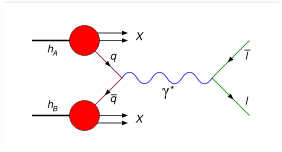|
|
The Drell-Yan process occurs in high energy nucleon-nucleon scattering. It takes place when a quark of one hadron and an antiquark of another (anti-)hadron annihilate and create a pair of oppositely-charged leptons. The production of such lepton pairs proceeds through the exchange of a virtual photon or Z-boson.
Drell-Yan process: a quark from one hadron and a antiquark from another hadron annihilate to create a pair of leptons through the exchange of a virtual photon. The Drell-Yan process is studied both in fixed-target and collider experiments. It provides valuable information about the parton distribution functions (PDF's) which describe the way the momentum of an incoming high-energy nucleon is partioned among its constituent partons. These PDF's are basic ingredients for calculating essentially all processes at hadron colliders. Although PDF's should be derivable in principle, current ignorance of some aspects of the strong force prevents this. Instead, the forms of the PDF's are deduced from experiment. The production of Z bosons through the Drell-Yan process affords the opportunity to study the couplings of the Z boson to quarks. The main observable is the forward-backward asymmetry in the angular distribution of the two leptons in their center-of-mass frame. If heavier neutral gauge bosons exist (see Z' boson), they might be discovered as a peak in the di-lepton invariant mass spectrum in much the same way that the standard Z boson appears by virtue of the Drell-Yan process. Retrieved from "http://en.wikipedia.org/" |
|

